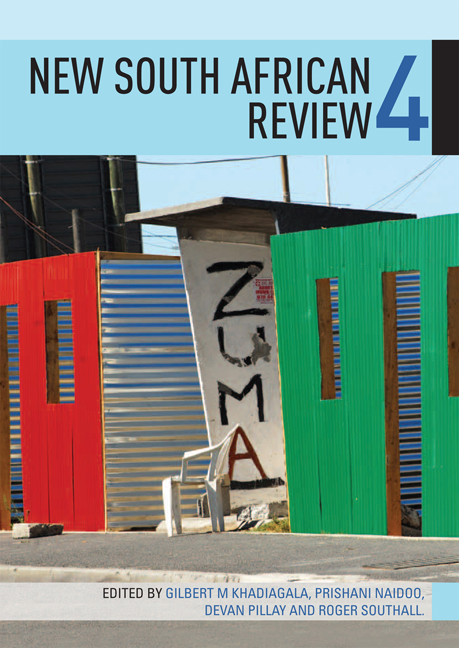Book contents
- Frontmatter
- Contents
- Preface
- Introduction: South Africa's fragile democracy: Twenty years on
- PART ONE ECOLOGY, ECONOMY AND LABOUR
- Introduction
- Chapter 1 The South African labour market after eighteen years: It's class struggle, stupid!
- Chapter 2 The state of organised labour: Still living like there's no tomorrow
- Chapter 3 Citizen Wal-Mart? South African food retailing and selling development
- Chapter 4 Transcending South Africa's oil depen
- Chapter 5 The politics of electricity generation in South Africa
- PART TWO POWER, POLITICS AND PARTICIPATION
- PART THREE PUBLIC POLICY AND SOCIAL PRACTICE
- PART FOUR SOUTH AFRICA AT LARGE
- Contributors
- Index
Chapter 5 - The politics of electricity generation in South Africa
from PART ONE - ECOLOGY, ECONOMY AND LABOUR
Published online by Cambridge University Press: 21 April 2018
- Frontmatter
- Contents
- Preface
- Introduction: South Africa's fragile democracy: Twenty years on
- PART ONE ECOLOGY, ECONOMY AND LABOUR
- Introduction
- Chapter 1 The South African labour market after eighteen years: It's class struggle, stupid!
- Chapter 2 The state of organised labour: Still living like there's no tomorrow
- Chapter 3 Citizen Wal-Mart? South African food retailing and selling development
- Chapter 4 Transcending South Africa's oil depen
- Chapter 5 The politics of electricity generation in South Africa
- PART TWO POWER, POLITICS AND PARTICIPATION
- PART THREE PUBLIC POLICY AND SOCIAL PRACTICE
- PART FOUR SOUTH AFRICA AT LARGE
- Contributors
- Index
Summary
INTRODUCTION
Other research (for example, McDonald 2009) has problematised the politics of social justice in electricity distribution and reticulation. This chapter will primarily explore the question of why a democratic government – under four successive presidents, and under seven successive ministers responsible for energy – has persisted in privileging the atomic industry lobby, regardless of the consequences for opportunity cost, cost-effectiveness, complexity, the potential for catastrophe, and constant change on the supply-side of the market and in technology.
HISTORICAL BACKGROUND
In 1923 the government founded the Electricity Supply Commission, Escom (later changed to the Afrikaans acronym Eskom) to nationalise some of the existing power stations, to build extra ones, and to start work on connecting what incrementally became a national power grid by 1975. For non-electricity sources of energy, the apartheid regime established Sasol, the world's largest coal-to-oil plant, which started production in 1955 and greatly ramped up production in 1981-82 when it feared that oil sanctions might become far more efficient than they were, and would be backed up by a naval blockade. It founded UKOR, the uranium enrichment corporation, primarily for a future atomic weapons programme, but which could have dual use to provide fuel for potential nuclear power stations. UKOR started operations in 1976, enriching the fissile isotope of uranium, 235U, from 0.7 per cent to 5 per cent strength, later increased to 45 per cent.
Today, 93 per cent of South Africa's electricity is generated by coal-fired power stations. The Medupi and Kusile power stations under construction will each rank as the fourth-largest coal-fired power stations in the world, and the largest to use dry-cooling and desulphurisation.
DEVELOPMENTS IN NEW SOURC ES OF ENERGY FOR THE GRID
In recent decades, new sources for energy became both technologically and financially feasible. While South Africa, largely a semi-arid country, has only small hydropower stations such as the! Gariep Dam, imported hydropower can be orders of magnitude larger, with energy security assured by tapping different sources and using different routes for transmission cables. Starting in 1976, Mozambique's Cahora Bassa hydropower plant (a project initiated by then presidents Hendrik Verwoerd of South Africa and Antonio Salazar of Portugal) exported around 1 100 MW to South Africa.
- Type
- Chapter
- Information
- New South African Review , pp. 91 - 108Publisher: Wits University PressPrint publication year: 2014



